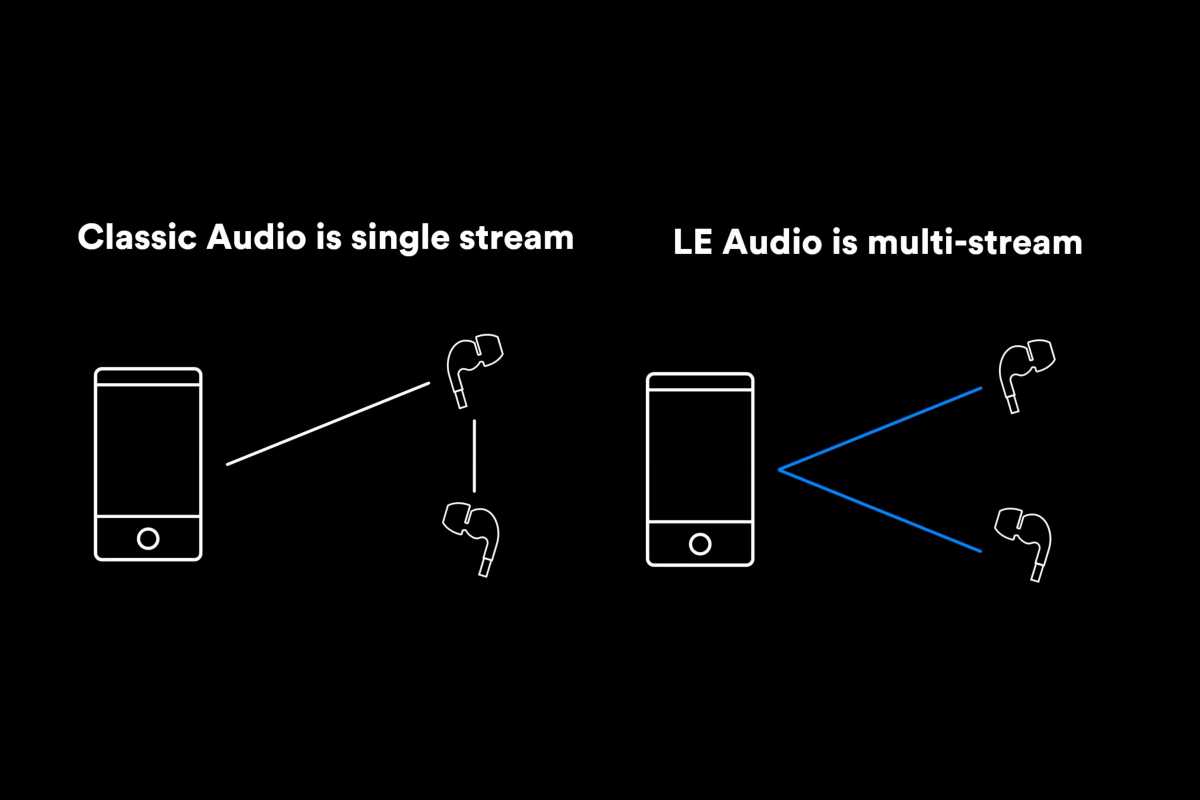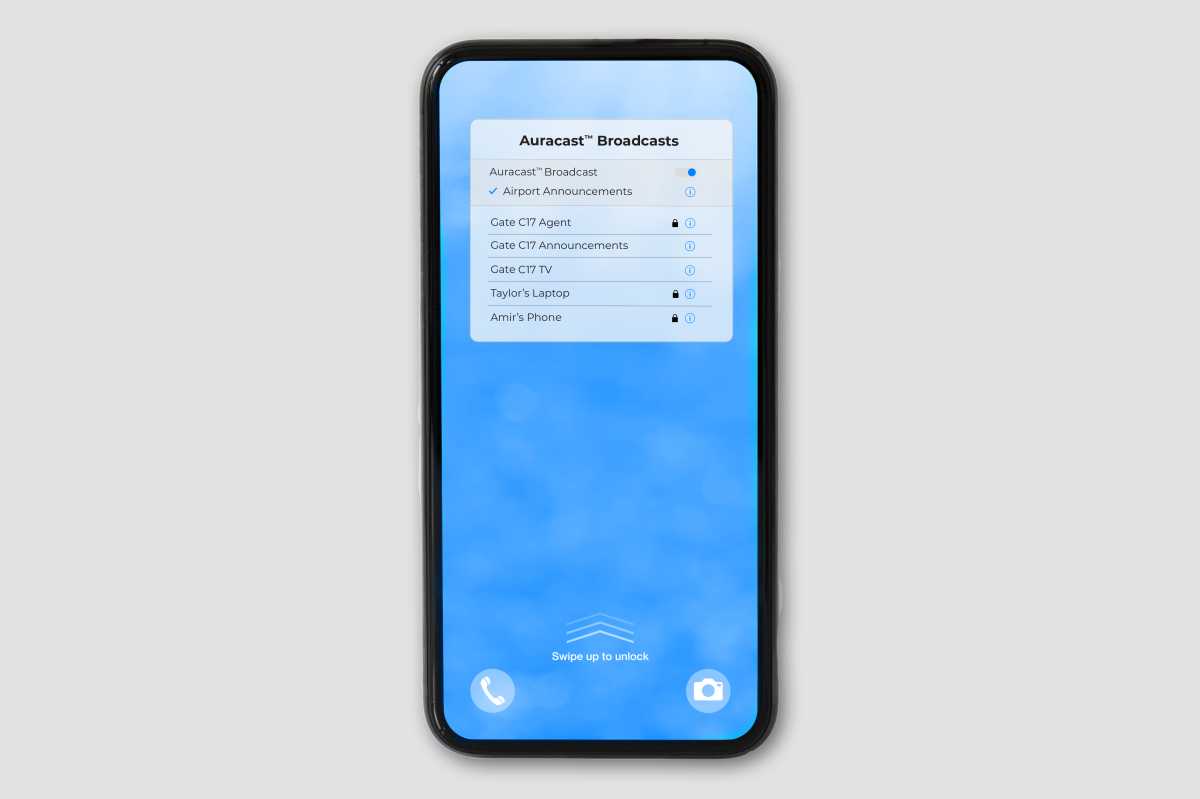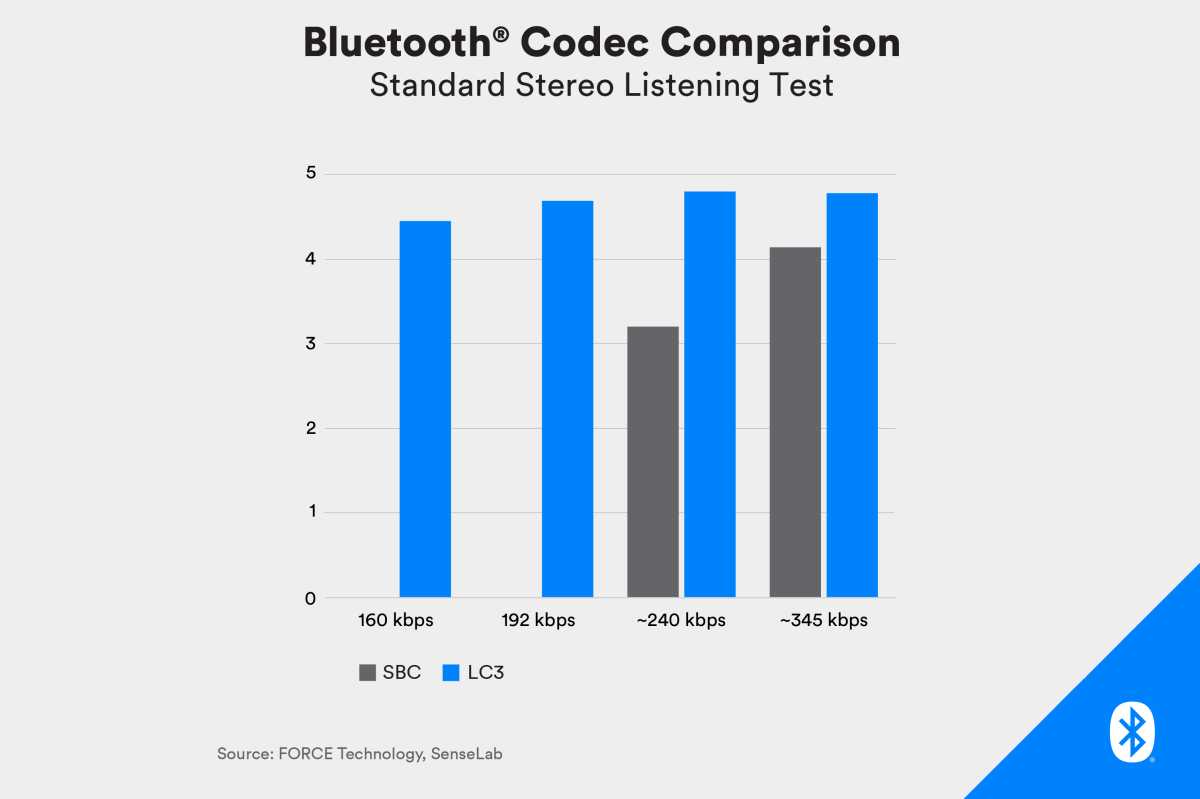You may have noticed that nearly all modern iPhones and AirPods list support for Bluetooth 5.0 (the first-gen AirPods supported Bluetooth 4.2). You might surmise, then, that audio streams are being sent using a modern, advanced Bluetooth connection. Not so fast!
With nearly all headphones (and phones, tablets, or laptops) that list Bluetooth 5.0 on the spec sheet, that’s not the case at all. The core Bluetooth audio standards used for nearly all wireless audio are based on what they call “Bluetooth Classic,” the foundation of which is Bluetooth 2.1 + EDR. That spec is around 15 years old, and while Bluetooth technology has gone through a bunch of changes and improvements since then, most of those improvements have been to enhance things other than the standard audio transmission used for music and calls.
More than two years ago, the Bluetooth SIG (special interest group) ratified a new Bluetooth 5.2 standard, and at the same time it introduced a new audio spec: LE Audio. (The LE stands for Low Energy.) Part of the LE Audio spec is a new audio compression codec: LC3. Together, these two technologies are poised to give wireless earbuds and headphones a massive leap forward in performance and features. Here’s what you need to know.
LE Audio
The big innovation of Bluetooth 4.0 was something called “Bluetooth Low Energy,” an entirely new protocol made to provide low-lantency, high-bandwidth connections using very little power. It evolved a lot over the next few releases, finally getting all the features required for today’s Internet of Things devices in Bluetooth 5.0. It’s Bluetooth LE that makes AirTags possible, for example.

Even the high-end AirPods Max don’t take full advantage of Bluetooth 5.
But the primary audio stack used for streaming music or making phone calls is still based on the old, slower, power-hungry Bluetooth 2.1 + EDR spec. These audio specifications are known as “Bluetooth Classic.” LE Audio builds a new next-generation audio stack on top of Bluetooth LE. Support for LE Audio requires the new Bluetooth Core Specification introduced in Bluetooth 5.2, but it is not necessary for all Bluetooth 5.2 devices to support LE Audio.
Many “Bluetooth 5” earbuds and headsets may be capable of Bluetooth 5 support, but they hardly make use of it. At most, they’ll use a Bluetooth LE connection for things like device discovery and pairing, or for data like reporting battery state. When audio data is transferred, it uses the old Bluetooth Classic frameworks. Apple doesn’t disclose exactly how AirPods work, but this is what we believe to be the case with them as well.
With LE Audio, all audio streams can be transferred using Bluetooth LE. This has the potential to have a big impact on battery life, extending battery life by as much as 50% or more in supported devices. But there are three other important features built into LE Audio that can really change the game for wireless audio.
Multi-stream audio: Bluetooth Classic supports a single audio stream for each source and sink (a source is something like your iPhone or laptop, a sink is a device like headphones or speakers). So to get stereo in a pair of true wireless earbuds, your iPhone will send a single stream to one earbud, which would then set up its own secondary link to the other earbud and forward the stream along. Then each earbud essentially filters out the left or right channel to play back the correct one. It’s a neat hack to work around the limitations of a 15-year-old standard, but a better way is sorely needed.
With LE Audio, the source device can send multiple separate independent streams to sink devices, and have them be very highly synchronized (within tens of microseconds). So your left earbud makes a connection to your phone and receives a stream of just the left audio channel, and your right earbud makes another connection to your phone to receive a stream of just the right audio channel, all synced up.

Bluetooth SIG
Broadcast and multipoint audio: Bluetooth Classic supports a single source device (your phone or laptop) and a single sink device (headphones or speakers). Clever developers have found some limited ways around this, but it has always been sort of a hack.
LE Audio supports more connection configurations, including mesh networks, one-to-many, and many-to-one connections. So you could have a single device send audio out to multiple sets of headphones at once. Or, you could have earbuds that are connected to both your phone and laptop simultaneously. Not seamless switching, but true multiple source audio.
What’s more, the spec builds in a technology that the Bluetooth SIG has branded Auracast. This is a way for a source to broadcast out a signal that can be “joined” by many users at once. Necessary info about the streams are sent out to your bluetooth source device (like your phone or laptop), which tells your paired sink (your earbuds or headphones) how to receive the correct audio stream.
Imagine a movie theater. You sit in your seat and take out your phone, which shows several broadcasts available nearby–multiple different language audio tracks for the film you’re about to watch. You select the language you want, and your paired earbuds automatically start receiving the proper audio broadcast stream. And this feature could be available to everyone in the theater, simultaneously. The same concept could revolutionize seminars and other large scale presentations.
Or consider a gym, which could offer multiple music “stations” for customers to tune in to with their Bluetooth headphones instead of blasting music with speakers over the sound of the banging weights and whirring ellipticals. It could also broadcast the audio from the mounted TVs on Bluetooth channels. Just pull out your phone, pick the music or TV audio you want to listen to, and your phone tells your earbuds how to connect to the gym’s broadcast system, after which they’ll directly receive independent streams directly from the source.
In addition to joining with a menu on your phone or laptop, you’ll be able to join broadcasts by scanning a QR code or tapping on an NFC tag.

Bluetooth SIG
LC3 codec: Bluetooth Classic only requires support for a single form of audio compression: the SBC codec (that’s short for low-complexity subband codec). Other codecs may be supported (Apple uses AAC, many others use Qualcomm’s AptX or Sony’s LDAC), but they’re entirely optional. LE Audio requires a new low complexity codec, LC3, that should be much better.
The LC3 codec
LC3 (short for low-complexity communications codec) is important enough to warrant a little further explanation. It’s technically just another way to compress audio, like SBC, AAC, AptX, MP3, and LDAC. It is not, as some have claimed, a “lossless” audio codec. But supporting it is a mandatory part of the LE Audio spec, and it’s a huge improvement over the old mandatory codec, SBC.
As with all lossy audio compression, it sounds better when you use a higher bitrate. But it’s much more advanced than SBC, while maintaining very simple decoding complexity that results in better battery life. It’s also much lower latency–we don’t have real-world figures just yet, but codecs like SBC and AAC often have a total latency of over 200ms, while LC3 has a default frame time of only 10ms, so even with a full encoding and decoding pipeline the latency is likely to be well under 100ms.

Bluetooth SIG
The Bluetooth SIG only really compares LC3 against SBC, its old mandatory codec, and finds that it has superior sound quality at half the bitrate or less. You can listen to a side-by-side example below. We recommend you use wired headphones, not Bluetooth headphones!
Later experiments among audio enthusiasts have shown that LC3 doesn’t quite match the quality of a really good AAC encoder at the same bitrate, but it gets fairly close, while featuring much lower latency and complexity.
Of course, just as with Bluetooth Classic, device makers won’t have to use LC3 compression all the time. It must be supported in the product to be a certified LE Audio device, but other optional codecs like AAC or AptX can still be used.
In other words, Apple might stick with AAC compression in future products that support LE Audio, but if the quality of LC3 is close enough, it might instead opt to use that for communication with AirPods in order to improve battery life and latency.
At least you’ll know that any product you buy that supports LE Audio will have the ability to use LC3. So a future iPhone connecting to a future car audio system, for example, may sound a lot better than the default SBC codec you sometimes get today. The lowest common denominator is getting much better, especially at really low bitrates, and that’s good for everyone.
Will LE Audio come to iPhones and AirPods?
Of course the big question is: When will Apple jump on the LE Audio bandwagon? Currently, the Bluetooth 5.2 spec and LE Audio are supported in Android 13, but not in any headphones I could find. Some claim Bluetooth 5.2 support, but that’s a foundation that is required for LE Audio—it doesn’t actually guarantee support for it. Qualcomm only just this year started shipping connectivity chips for devices and a platform for earbuds (QCC5171 and QCC307x) that include support for LE Audio.
So it’s coming, and soon, but it’s anyone’s guess as to when it might show up in an Apple product.

Cound the upcoming second-gen AirPods Pro use Bluetooth LE Audio?
Certainly, for source devices like iPhones, iPads, and Macs, new hardware will be required. It’s highly unlikely that Bluetooth 5.2 support and LE Audio can be added in a firmware update. It’s unclear if the current H1 processor found in third-generation AirPods, AirPods Pro, and AirPods Max are capable of being upgraded to support the spec, but it’s doubtful.
However, some have claimed that a beta firmware update for the AirPods Max, coinciding with the Developer beta of iOS 16, have enabled support the LC3 codec on that device. This isn’t necessarily an indication that LE Audio is coming to them–it is entirely possible to use the LC3 codec with Bluetooth Classic, in the same way Apple chooses to use AAC now instead of the SBC codec. You don’t get all the other benefits of LE Audio, but the switch to a lower-complexity and lower-latency codec might improve battery life or have other benefits.
It really seems like more of a question of when rather than if Apple products will support LE Audio. It’s the first major overhaul of the Bluetooth audio standards in nearly 20 years, and has major benefits for all. LE Audio and LC3 do everything that A2DP (Advanced Audio Distribution Profile, the current audio streaming Bluetooth technology) and HFP (Hands-Free Profile, the current Bluetooth tech for making hands-free calls in cars and the like) can do, only better, and a whole lot more too.
Within a year or two, LE Audio will be a part of nearly all popular wireless chipsets and their software stacks, and commonplace among at least premium Android devices and many new cars. Without it, Apple risks being left behind, and while it might find its own proprietary way to include similar features in future AirPods, it would be a terrible idea for iPhones to be stuck using Bluetooth Classic when connected to any non-Apple device.




